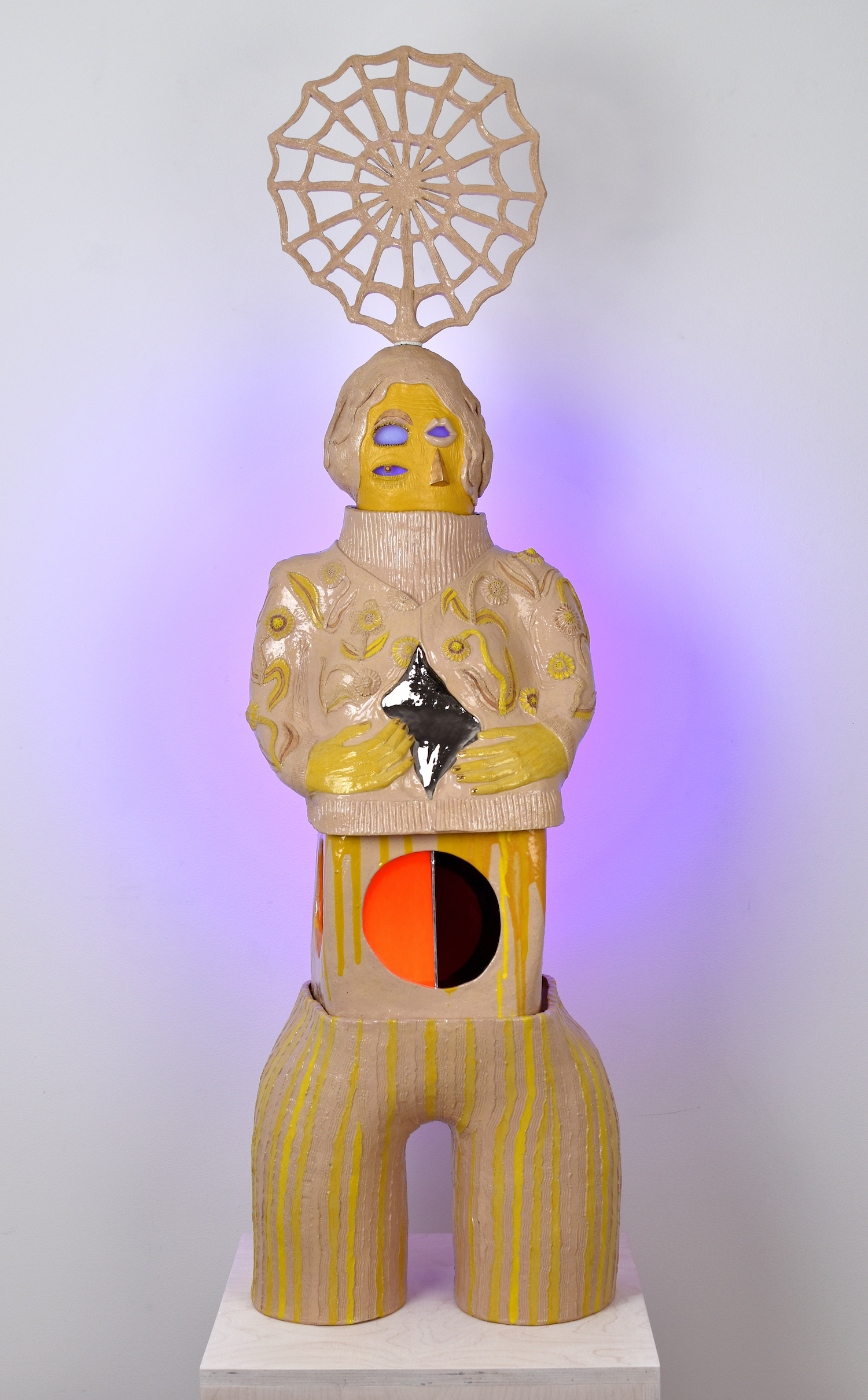GHOST
GARMENT
GARDEN: Emily Counts
October 30 – December 4, 2021Your grandmother’s face shows the heaviness and joy of years gone by. She slips into her costume jewelry, colorful plastic chunks resting on her fingers. Her sweater is an embroidered orchestra of pattern and color. You love her with a certain kind of intensity—for her magic and mystery, for giving you a glimpse into your own future.
In GHOST GARMENT GARDEN Emily Counts celebrates the aesthetic maximalism and intrinsic magic of grandmothers. These vibrant ceramic works, many of which are self-portraits, contemplate her present body and experience, while also imagining her future self. Through the grandmother figure, and by exploring her relationship to the natural world, Counts invites a sense of optimism and power to the aging process.
GHOST. Her hands melt into her hips as she dons a power pose in her red power suit. Her features are mixed up like in a dream, a mouth where there should be an eye. A light glows between her legs and eyes, her body expanding beyond her hard ceramic form. Ghost Power Suit is one of a series of ceramic bodies, each with their own personality and specificity, within Counts’ new series. Some people think that spirits live on through our memories or through the objects left behind. For others, ghosts visit in dreams, in the slippery spaces between sleeping and waking. With her illuminated, supernatural forms, Counts invites all possibilities and definitions of “ghost.”
GARMENT. Her body is in repose, stretched across six panels of ceramic relief. She wears a red and orange sweater patterned with jagged, textured flowers and an oversized ruffled collar. Her orange and purple cable knit pants play a starring role until they disappear under a white cat laying on her shins. Behind them stripes of vines climb up the wall. A hand drops a phone down with yellow waves emanating from the receiver—a message from another realm? With Seashell is Calling and other works in GHOST GARMENT GARDEN, Counts indulges in the maxmilist spirit through clothing, embellishment, pattern, color, and symmetry. Like ornamental objects and heirlooms, garments become not simply a necessity, but an opportunity for joy, remembrance, and contemplation.
GARDEN. Counts cultivates a garden of ceramic cone flowers, weeds, thistles, dandelions, mushrooms, spiders, and berries. These natural, often medicinal, elements appear throughout GHOST GARMENT GARDEN. Drooping petals, like wilting flowers in a Dutch still life, hint at the inevitability of decay and death. But with the giant morel mushroom with a gleaming rootbeer-hued glaze, Counts shows how beauty can come from decomposition. In the ceramic relief titled, Warm Nest, two kittens lay face-to-face; their noses touch as their bodies create a balanced circle with flowers at the center. Within this cycle there is always a place for new and old life. The body, the flower, the berry, the kitten dies as it lives.
GARDEN. Counts cultivates a garden of ceramic cone flowers, weeds, thistles, dandelions, mushrooms, spiders, and berries. These natural, often medicinal, elements appear throughout GHOST GARMENT GARDEN. Drooping petals, like wilting flowers in a Dutch still life, hint at the inevitability of decay and death. But with the giant morel mushroom with a gleaming rootbeer-hued glaze, Counts shows how beauty can come from decomposition. In the ceramic relief titled, Warm Nest, two kittens lay face-to-face; their noses touch as their bodies create a balanced circle with flowers at the center. Within this cycle there is always a place for new and old life. The body, the flower, the berry, the kitten dies as it lives.















